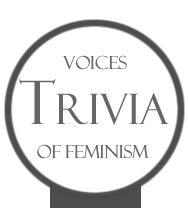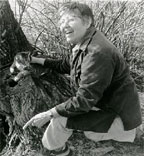LESBIAN: GOING ALL THE WAY
Margie Adam
By the time I reached my 15th birthday, I was old. I smoked unfiltered Camel cigarettes and I had had sex with most of the boys in the neighborhood including my younger brother. I had mastered the public transport system so I could escape the stifling little town I lived in. Early every Saturday morning I boarded the Greyhound bus for the freedom of Santa Barbara, the big city to the south with its single outdoor beatnik cafe. There I sat all day long drinking black tea, reading Eugene Ionesco and Teilhard de Chardin and writing in my diary.
I talked my parents into enrolling me in Marymount School, a private Catholic girl's boarding school in Santa Barbara, because I already knew that graduating from Lompoc High School was a dead end. I arrived at this bastion of custom and convention wearing a rock on a leather thong around my neck. I resisted wearing the uniform—which included white oxfords and a flimsy short-sleeved blouse—and was repeatedly sent back to the dormitory to change out of my loafers and long-sleeved, button-down collared shirts by the nun in charge. I felt it was enough that I was wearing a skirt, something I hated doing. Still, I was happy for the rigorous educational setting, and quick to find a special friend who also liked madrigals, poetry and long walks behind the campus.
She and I became inseparable. By the end of my first term at this tightly stratified girls social setting, we were the source of jokes and whispers, jealousy and resentment. We were both smart, talented, attractive, and rebellious. And we were crazy about each other.
As these things go, things went...the skipped classes spent together in an isolated garden grotto led to a series of dramatic events and angst-filled encounters with the principal and parents...an ever-intensifying awareness of every moment in each other's presence... and then one night, at the end of December 1963 she was visiting me in Lompoc over the holidays.
We had been talking for hours. First, we had turned the overhead lights off, then the side table lamps. Now we were in the dark - talking and talking, telling each other things we had never told another soul.
It was very late. We were tired. And suddenly, we came to the end of everything there was to say.
There was a silence in the darkness that was rich with expectancy—rich and thick—and sweet like butterscotch. Out of nowhere, up from the depths of my central self, came a surge of desire so overwhelming that I was faint. This feeling was accompanied by two crystal clear thoughts: I want to kiss her. I am going to kiss her.
Let me be clear: It had never occurred to me to kiss a girl. I had only kissed boys...and not the boys in the neighborhood. Not those boys. Only the two young men who had asked me to "go steady," neither of whom I had allowed to go "all the way."
Thirty seconds elapsed from the surge of desire, my determination to act and the act itself. Thirty seconds to travel the distance through social convention and familial expectations to a place so far beyond the pale I had never imagined such a land existed. I kissed her and I was immediately home. Some unhinged, untethered, unfinished, untenable existence came to an end.
Everything made sense. I had no language for where I was or who I was but I felt comfortable in my skin for the first time in my life. This enfolding, intoxicating, unbound passion was connected to the young woman in my arms. It was about both of us being young women entwining legs and arms, pressing hard against each other, reaching into each other with tongues and fingers, searching gloriously for the center place, for the core.
It is now decades later and it is the same for me, this passion. Only now I know who I am, what I am. I am a lesbian.
When I came out in the sixties, "coming out" meant reinventing the world. It meant blowing a hole in the constricting walls of homophobia in my personal life, in my culture and in American politics by living out my woman-loving ways each day. It meant clearing a new and shining path in the world with my woman lover for other lesbian and gay people to walk—-to be visible in all our stunning complexity. So much of claiming the word "lesbian" for me was about identifying myself in a public way, in word and deed. Coming out was literally claiming space for my reality in a world that was bent on disappearing me, disappearing my accomplishments and aspirations as well as those of all gay people.
The world I inhabit today with my Scottish lover who is just coming out is very different from the one I encountered when I came out in 1963. Lesbian and gay couples have the legal right to marry in a handful of states and in some countries around the globe. Gay people are visible everywhere in the media, the arts and politics.
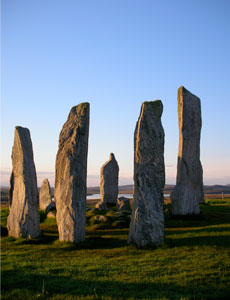 Callanish Stones, Isle of Lewis |
At the same time, my lover lives in a town on an island off the mainland of Scotland, light-years away from the more cosmopolitan cultures of San Francisco and Glasgow. As she contemplates her future with a woman lover, she feels certain she will be formally sanctioned by her church elders. Her friends make derogatory and demeaning comments and one is "infuriated." Infuriated about what? She has been told in no uncertain terms to "Sort yourself out!"
Her friendship circle lives in the 21st century with the rest of us. These women are all educated. They have traveled around Europe and have access to CNN. They are not ignorant...and yet they are intolerant. There is no doubt that they would respond differently if my lover was involved with a man. They feel permission to denigrate and dismiss her deepest feelings because she has fallen in love with a woman.
Of course, the social stigma that my lover is encountering is not limited to the Outer Hebrides but surely exists in communities all over the world. It remains the sad truth that civil rights and social acceptance of lesbians is still a struggle-in-process. We are nowhere near the end of homophobia and woman-hatred as organizing principles for Radical Right fund-raising efforts.
Here in the United States things are different. Lesbian couples have the right to marry in five states. However, within lesbian communities, things are not simple like they were in 1963 when two young women kissed for the first time.
With the advent of queer studies and a more complicated assessment of gender, there is no longer agreement about what the word "woman" means, let alone "lesbian." Some male-to-female and female-to-male transsexuals identify themselves as women; some identify themselves as lesbians. In the 70s, Alix Dobkin wrote a song with the lyric: "Any woman can be a lesbian." Can a man?
What - finally - does it mean to be a lesbian if a woman whose primary sexual relationship is with a man identifies herself as a lesbian? These aren't glib questions in a world that still tolerates societal ostracism, religious sanction and violence against gay people.
What do I mean when I call myself a lesbian? Maybe that's the only question that I can discuss with authority at this point since immediately beyond my point of view a raging argument is taking place, full of righteous anger and intimidation.
My definition of "lesbian" is a spiritual, psychological, sociological, cultural and political construction which is both orienting and clarifying for me, and is grounded in a life experience spanning over four decades from the mid-sixties when the American Psychiatric Association listed homosexuality as a mental disorder. It is a name I have claimed by crawling over the glass of my own woman-hatred and internalized homophobia. It is a word that sings to me here in the early 21st century at a time when the word itself and its meaning are being threatened with utter obliteration.
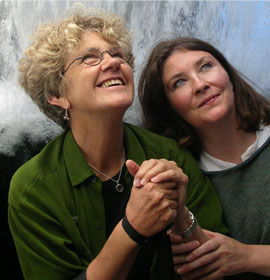 Margie and Ruth |
Today, having just turned sixty-one and fallen in love with a 39-year old woman...being a lesbian is still about holding a space for woman-loving in my personal and public life. It is still about the heady first kiss-this time between two women on a moonlit Hebridean beach. It is about the unique scent that rises in the heated space between breasts and between hips.
It is deeply unnerving to me to know that in certain circles within the lesbian-gay-bisexual-transgender-intersex-queer-questioning (LGBTIQQ) community, the word "lesbian" and its association with feminism have become so charged that it is actually considered by some to be old-fashioned, or downright oppressive in itself. In this context, to insist on the space for lesbians who are woman-born woman who love women-born-women is seen in itself a kind of exclusion of others rather than an acknowledgment of our particular history, a celebration of a uniquely empowered and utterly exquisite identity which we have struggled through centuries to claim.
Lesbian, as a descriptor, is simultaneously being vilified and drained of its meaning within parts of the LGBTIQQ community even as the mainstream straight community continues to conflate all lLGBTIQQ people into a single male-identified adjective like "gay" or "homosexual."
Every time I hear a lesbian describe herself as "queer" or "a gay woman" I feel my life being disappeared. It is about language-the power of language-and the adjacent power of disapproval, peer pressure, subtle forms of woman hatred and homophobia to silence the naming of ourselves as lesbians.
The challenge for lesbians who came of age in the 1960s and 1970s in the midst of the women's liberation movement-where we fought to hold a space with straight feminists as we all fought to create space for all women-is to hold on to a feminist vision of the world which is inherently inclusive...one where queer consciousness which recognizes the fluidity of gender can coexist with a woman-centered lesbian sensibility and culture.
This is to reject all subtle and obvious impulses to create a hierarchy of suffering in which members of the latest "most oppressed" of the sexual minorities feel entitled to claim lesbian space and simultaneously collapse our identity with a critique which defines our very existence as out-of-date and, by nature, discriminatory.
Soon I will travel to Scotland to meet my new lover's parents and friends. From decades of experience, I anticipate they will be confounded by a simultaneous emotional attraction as well as a resistance to me related to what they "think" about who and what I am. This will create a very complicated reaction that each one of them will have to navigate. Perhaps they will ignore the fact of my being a lesbian. Perhaps they will put me in a category of my own, "not like the others." Perhaps they will be civil but not friendly. Regardless, I will stand in front of them, a blazing lesbian, fully formed and proud of my identity, my sensibility and culture.
This simple act of claiming space for woman-loving is what it means to me to be a lesbian. It is a bridge that I rebuild over and over again to that singular moment in the late night December darkness in 1963. Over and over again, as I honor my lesbian self, my life is refreshed from the arid, two-dimensional terrain of invisibility into a lush landscape that I now inhabit effortlessly—one where I have planted melodies and love relationships and a life-affirming vision that nourishes me and all those around me.
About the Author
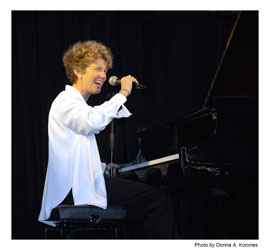
Margie Adam is a singer-songwriter-pianist and one of the founder-organizers of Women's Music, a Second Wave feminist cultural initiative fueled by lesbian passion. Her song, "We Shall Go Forth!" resides in the Smithsonian's Political History Division. She is associate producer of two films, Radical Harmonies: A History of Women's Music and No Secret Anymore! The Times of Del Martin & Phyllis Lyon. Work with the labyrinth inspired two recent projects, Avalon, a vocal recording and PORTAL, a multi-media work featuring her contemplatiove solo piano music and photography of Scotland's ancient Callanish Stones. Currently, Margie is completing a PhD program related to future work as an Integrative Counselor committed to creating a safe, empowering, and joyful environment for women in transition.
Margie's website – www.margieadam.com --includes an extensive list of links on the CONNEXIONS page. Here you will find listings for many feminist musicians and artists, feminist and progressive organizations, projects, and initiatives. Margie encourages others to "cut and paste" this list for use as a basis for our own Feminist Links Pages, reinforcing the ancient feminist practice known as "word of mouth."
Join our Trivia - Voices of Feminism group on Facebook
